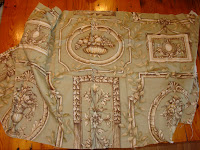My favorite way to update a room quickly is with new pillows. Its such a simple way to add color, texture, or pattern, whenever the mood strikes. Usually its the change of seasons that inspires me to add a new pillow (or two)
so I am regularly adding to my collection.
Today I decided to finally use the fabric I bought months ago to make a couple of new pillows for my family room couch. Here I will show you how to make a two sided pillow with decorative cording.
First, gather your supplies...fabric, pillow forms - this is easy...just head to the "pillow closet" and use the inside of an old, retired pillow from last season...no need to buy a new one! What?...you don't have a "pillow closet"?! OK, you can purchase new forms or batting to stuff your pillow. Thanks to my pillow obsession, I have more than enough to keep me supplied for every season or mood that strikes!
I picked a fabric with an overall pattern for one side and a medallion design for the other.
First lay out your old pillow cover to use as your pattern. Just measure the width and add 1 inch to allow a 1/2 inch seam on all sides.
Next, mark your fabric and cut out the square.
Repeat this step for the coordinating medallion fabric. NOTE: If you are using a fabric with a print, be sure to align your top square over the area you want centered on your pillow. I chose to feature one of the medallions as my focal point for this side.
Now you can pin your cording to the edge of one of your squares.
I like to sew the cording to this piece first...although some may consider this an extra step, I think it makes it easier to sew all three pieces together.
Once you are done sewing the cording on to one side, you can sew the three pieces together. Be sure to place fabric face to face and sew pillow square inside out...leaving an opening on one side to insert your pillow form.
All that's left now is to hand stitch your opening closed...and you are done!
I love the new addition to the family room...although it does look a little lonely sitting there all by itself! No worries...my next post will be a DIY for a simple flange pillow I made to keep this one company!






































